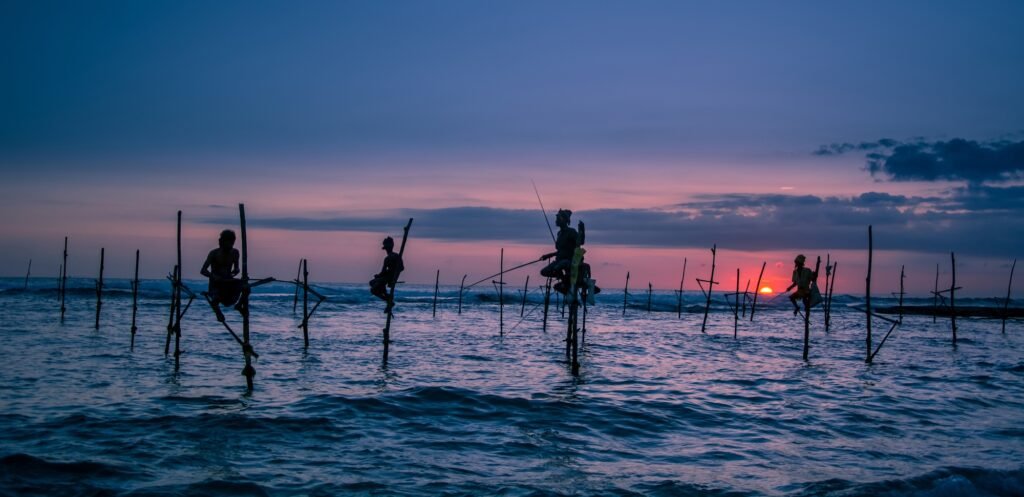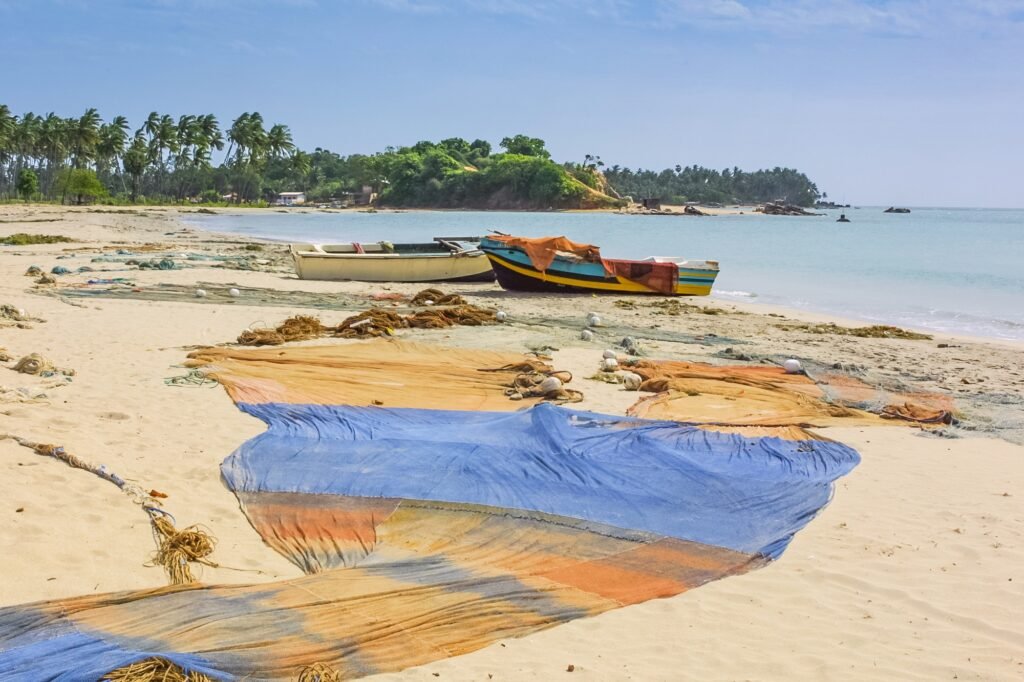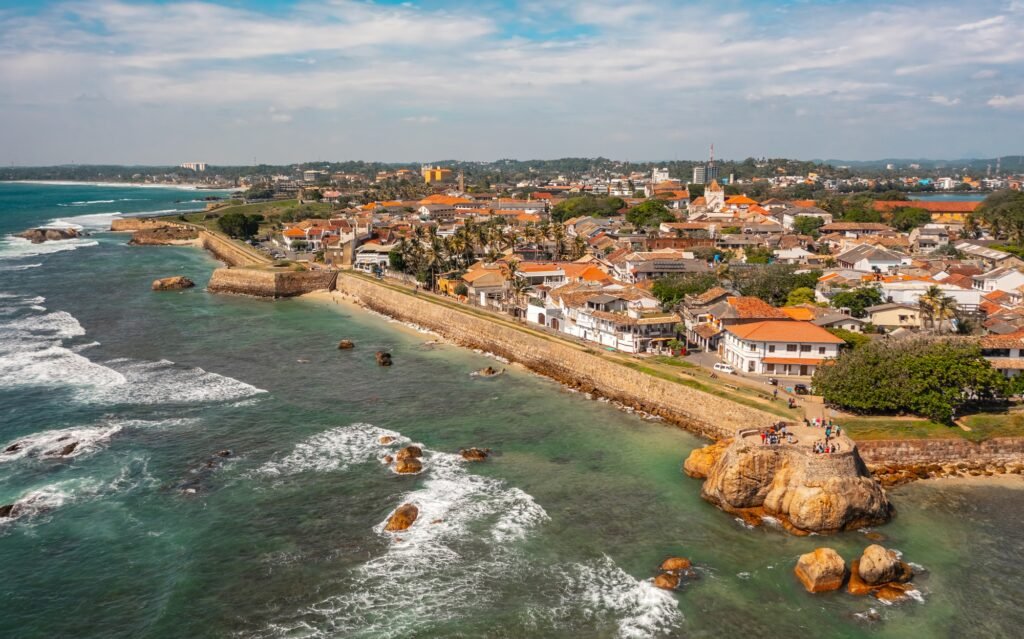Introduction to Sigiriya
Located in the heart of Sri Lanka, Sigiriya, also widely recognized as Lion Rock, stands as one of the country’s most remarkable landmarks. This ancient citadel, which dates back to the 5th century AD, is not only a testament to incredible engineering but also a profound symbol of Sri Lanka’s rich cultural heritage. The majestic Sigiriya Rock Fortress is perched atop a massive granite outcrop that rises approximately 200 meters above the surrounding plains, offering breathtaking panoramic views that captivate visitors from all over the globe.
What makes Sigiriya particularly alluring is its intriguing combination of natural beauty and historical significance. Designated as a UNESCO World Heritage site, Sigiriya showcases a unique blend of urban planning, art, and architecture reflective of ancient Sri Lankan civilization. It attracts a diverse range of tourists, including history enthusiasts, nature lovers, and adventure seekers, all eager to immerse themselves in the site’s storied past and scenic beauty.
The rich history of Sigiriya is intertwined with various legends, one of which speaks of King Kasyapa who, After seizing the throne through patricide (killing his father, King Dhatusena), Kassapa built Sigiriya as a fortress-palace. The remnants of the royal gardens, water systems, and Visitors encounter the famous Sigiriya frescoes mid-way, preserved in a sheltered niche on the western rock face. present an opportunity for visitors to experience the luxurious lifestyle once enjoyed by the ancient inhabitants. Moreover, the insights provided by expert guides during a Sigiriya guided tour in Sri Lanka allow for a deeper understanding of the fortress’s significance and the various aspects of its history.
For those contemplating a visit, the best time to visit is during the dry months, either from December to March (high season) or May to early September (regional dry period), when the weather is conducive for climbers. Whether you are climbing Sigiriya to witness the stunning frescoes or encountering the impressive lion’s paws at the base before ascending, the journey to the top is as enriching as the destination itself. As you explore Sigiriya, prepare yourself for a remarkable blend of culture, history, and awe-inspiring views that will undoubtedly leave a lasting impression.
The Historical Significance of Sigiriya
Sigiriya, commonly referred to as Lion Rock, stands as one of the most significant historical sites in Sri Lanka, encapsulating a rich tapestry of culture and architectural prowess. Originating in the 5th century AD during the reign of King Kassapa I, Sigiriya became a royal citadel, strategically positioned atop a massive rock formation. This location not only provided a formidable defense against invaders but also served as an idyllic retreat for the king, enhancing its allure.
The construction of Sigiriya exemplifies advanced engineering and artistic ingenuity of ancient Sri Lanka. The site features innovative landscaping including sprawling water gardens, terraced gardens, and the famous frescoes that adorn the rock face. These frescoes, showcasing celestial maidens, not only reflect the artistic expression of the time but also highlight the cultural significance of this ancient citadel. The architectural layout, characterized by ornate paths leading to the summit, underscores the meticulous planning that went into establishing the fortress.
In the context of its political history, the transformation of Sigiriya from a royal residence to a Buddhist monastery after the death of King Kassapa reflects the dynamic socio-religious landscape of ancient Sri Lanka. Throughout the centuries, Sigiriya has maintained its prominence, leading to its designation as a UNESCO World Heritage Site, a recognition that cements its status as an important archaeological and historical location. Today, visitors to Sigiriya can explore its magnificent remnants, such as the Lion’s Gate, which symbolizes the king’s authority and is a focal point for understanding the site’s purpose.
Overall, the historical significance of Sigiriya extends beyond its physical structures; it embodies the legacy of King Kassapa I and serves as a testament to the sophisticated civilization that thrived in Sri Lanka during his reign. From its architectural significance to its role in royal narratives, Sigiriya remains a crucial part of the broader understanding of Sri Lankan history.
Legends and Myths Surrounding Sigiriya
Sigiriya, often referred to as Lion Rock, is steeped in a rich tapestry of legends and myths that contribute to its mystique and allure. Central to many of these stories is the tragic figure of King Kassapa, who reigned during the 5th century AD. It is said that after murdering his father, King Dhatusena, Kassapa built the extraordinary rock fortress as both a palace and a sanctuary from retribution by his brother, Moggallana, who sought vengeance and claimed the throne. This act of betrayal is not merely a historical account; it paints a vivid picture of familial conflict, ambition, and divine intervention.
While the historical roots of Sigiriya are well documented, the site has also inspired various interpretations and local folklore. Some view the fortress as more than just a royal palace — a place with mystical energy and spiritual presence. The famed frescoes, often believed to represent apsaras or celestial maidens, add to this aura of divine beauty. Though not tied to any specific mythology, these artistic depictions continue to spark wonder and reflection, blurring the line between historical grandeur and timeless imagination.
Moreover, the rich narratives surrounding Sigiriya add depth to its already striking presence — from tales of royal ambition to interpretations of spiritual symbolism. The sophisticated water gardens that stretch out at the base of the rock are a testament to ancient ingenuity, admired for their precise symmetry and advanced hydraulic systems. As you ascend Sigiriya, you’re not just climbing a rock — you’re moving through layers of history and imagination. From the story of King Kassapa’s bold reign to the enduring mystery evoked by frescoes and ruins, Sigiriya invites every visitor into a powerful dialogue between past and present.
Exploring the Ancient Architecture
Situated in the heart of Sri Lanka, Sigiriya, also known as Lion Rock, is not merely a breathtaking natural formation but a testament to the architectural brilliance of ancient Sri Lankan civilization. This rock fortress, built in the 5th century by King Kasyapa, demonstrates a harmonious blend of natural and man-made structures. Climbing Sigiriya offers visitors an opportunity to observe the innovative design and engineering techniques deployed to create this extraordinary site. The ascent is punctuated by a series of steps carved into the rock, leading visitors past the remnants of captivating frescoes that vividly illustrate the skill of ancient artists.
The Sigiriya frescoes, renowned for their vivid colors and delicate details, adorn the western face of the rock. These paintings, believed to depict celestial maidens, are not just artistic marvels but also provide insight into the cultural and social mores of the time. Additionally, the gardens surrounding the fortress are exemplary of ancient hydraulic engineering, featuring sophisticated waterworks that include ponds, fountains, and terraced gardens, which are some of the oldest in the world. These water gardens are particularly noteworthy as they employ an elaborate system to manage water flow, thus enhancing both aesthetics and functionality.
The well-preserved integrated layout of the Sigiriya rock fortress indicates a deliberate spatial organization that reflects the significance of the site in Sri Lankan history. Each element, from elaborate pavilions to the carefully constructed walls, contributes to the fortress’s grandeur. Moreover, Sigiriya’s designation as a UNESCO site further emphasizes its importance as one of the premier examples of ancient urban planning and architectural ingenuity in Sri Lanka. The historical significance and artistic value of Sigiriya make it a must-visit destination for those interested in ancient citadels and their intricacies.
The Climb to the Summit: What to Expect
The ascent to Sigiriya, or Lion Rock, is an adventure that promises both physical challenges and breathtaking vistas. For many travelers, climbing Sigiriya is not merely about reaching the summit, but rather experiencing the historical significance and stunning scenery that this ancient citadel has to offer. The climbing route is well-marked and consists primarily of a steel staircase that leads visitors up the sheer rock face, strategically placed to ensure safety while allowing you to focus on the beauty surrounding you.
As you begin your ascent, expect to tackle several steep sections interspersed with landings that provide opportunities to pause and appreciate the remarkable Sigiriya frescoes. This visual journey through history, depicting celestial maidens, is one of the highlights along the way. Keep in mind that the entire climb has approximately 1,200 steps which can be quite taxing, especially in the tropical heat, so it is advisable to wear appropriate footwear and to stay hydrated. Planning your visit in the early morning or later in the afternoon can help alleviate some of the challenges presented by the sun.
A well-prepared traveler should also be aware of the physical requirements for tackling such an impressive landmark. While the climb is suitable for most people, those with mobility issues may find certain sections difficult. Therefore, taking your time and pacing yourself is key. Consider carrying lightweight gear, as heavy backpacks can impede your progress. Making use of resting spots not only offers a chance to catch your breath but also to soak in the stunning panoramic views of the surrounding landscape, which includes the expansive Sigiriya water gardens.
For a truly enriching experience, you might want to consider joining a Sigiriya guided tour Sri Lanka. These tours often offer insights into the historical context of the site, adding depth to your visit. In conclusion, the climb to the summit of Sigiriya is not just an exercise in endurance; it is an unforgettable journey through history and nature. Remember to prepare adequately and savor every moment of this unique encounter with one of UNESCO’s distinguished sites in Sri Lanka.
The View From the Top: A Breathtaking Experience
Reaching the summit of Sigiriya, also known as Lion Rock, is a remarkable experience that extends beyond the physical exertion of climbing. As visitors ascend the steep and winding pathway, they are greeted with a stunning vista that unfolds progressively. Upon arrival at the top, one is enveloped in a panoramic view of the surrounding landscape, which boasts lush greenery, serene water bodies, and distant mountain ranges. This breathtaking perspective serves not only as a reward for the climb but also highlights the strategic importance of the ancient citadel.
Sitting atop Sigiriya Rock Fortress, it becomes evident why this location was chosen by King Kasyapa as his royal residence in the 5th century. The elevated position allows for early warning of potential threats, a vital aspect of its historical function. Here, the remnants of ancient structures, palaces, and gardens, all engraved with rich history, invite contemplation on the lives once led in this extraordinary locale. Visitors can also gaze upon the exquisite layout of the Sigiriya Water Gardens, renowned for their intricate design, which once complemented the majestic rock fortress.
For those keen on photography, the view from above provides countless opportunities to capture the enchanting scenery. The combination of historical architecture against the vibrant colors of nature creates an awe-inspiring backdrop. Furthermore, the ambiance is enhanced by the sounds of wildlife punctuating the air, adding another layer to the overall experience. Adventurers and history buffs alike will find immense appreciation in standing atop this UNESCO site in Sri Lanka, where the essence of both nature and ancient human ingenuity coalesce beautifully.
Practical Tips for Visiting Sigiriya
Visiting Sigiriya, often referred to as Lion Rock, is a pivotal part of exploring the cultural heritage of Sri Lanka. One of the most crucial aspects to consider is the best time to visit this UNESCO site. The ideal months are from December to March when the weather is dry and cooler, making climbing Sigiriya considerably more comfortable. Avoiding the midday sun can enhance your experience, so it’s advisable to visit in the morning or late afternoon.
As for entrance fees, the cost is generally reasonable, but it is subject to change. Ensure that you check the latest prices before your visit, as these can vary depending on whether you are a local or a foreign tourist. There are several options for guided tours that provide invaluable insights into Sigiriya rock fortress history, including details on the amazing frescoes that adorn the walls.
Accessibility should also be considered. The climb to the summit involves about 1,200 steps and may not be suitable for individuals with mobility issues. However, for those who can manage the hike, the breathtaking views from the top make it well worth the effort. Make sure to wear comfortable shoes and carry plenty of water to stay hydrated.
Beyond Sigiriya, there are several nearby attractions worth your time. The Dambulla Cave Temple is a short drive away and provides a fascinating glimpse into ancient Buddhist art and architecture. A guided tour that includes both Sigiriya and Dambulla can offer a comprehensive understanding of the region’s significance. Additionally, the Sigiriya water gardens are a must-see, showcasing ancient irrigation techniques and beautiful landscapes.
Incorporating these practical tips into your travel plans can significantly enhance your visit to the ancient citadel of Sigiriya, ensuring you make the most of this iconic site in Sri Lanka.
Cultural Etiquette and Respect for Heritage
When visiting Sigiriya, also known as Lion Rock, it is essential to adhere to cultural etiquette and demonstrate respect for the rich heritage embedded within this UNESCO site. Sigiriya serves as a historical monument and a remarkable showcase of ancient Sri Lankan civilization, making it imperative for visitors to be mindful of local customs and traditions. Visitors should acknowledge that Sigiriya is not merely a tourist attraction but a treasured cultural landmark.
One of the critical aspects of visiting Sigiriya is dressing appropriately. Modesty is highly valued in Sri Lankan culture; therefore, wearing clothing that covers the shoulders and legs is encouraged. This practice demonstrates respect for the local customs and ensures a more positive engagement with the local community. Additionally, visitors should be respectful while exploring the various sites within the royal grounds, refraining from loud conversations or disruptive behavior that could detract from the historical significance and the tranquil atmosphere of the environment.
Maintaining the integrity of the site is another vital consideration. Travelers should resist the temptation to touch or climb on the ancient structures, such as the Sigiriya frescoes, which represent significant artistry of ancient times. Engaging with a Sigiriya guided tour ensures that guests are aware of which areas are sensitive and must be preserved. Furthermore, visitors can contribute positively to the preservation of this ancient citadel by utilizing marked pathways and disposing of waste responsibly, thus protecting the stunning water gardens and other ecological features around Sigiriya.
In addition, purchasing souvenirs from local vendors can support the economy and promote sustainable tourism. By engaging with local artisans, travelers not only take home a unique piece of Sri Lanka but also partake in preserving and promoting the traditional crafts that are part of Sigiriya’s cultural heritage. A respectful approach fosters a more enriching experience for visitors and local communities alike.
Conclusion: Sigiriya’s Timeless Allure
Sigiriya, often referred to as Lion Rock, is not merely an ancient citadel; it is a symbol of Sri Lanka’s rich history and cultural heritage. The grandeur of Sigiriya, coupled with its breathtaking natural surroundings, creates a unique experience that captivates visitors from around the globe. The journey to this UNESCO site in Sri Lanka, both challenging and rewarding, unveils the fascinating stories rooted in its rock fortress history.
As one climbs the impressive stairways of Sigiriya, it is not only the physical ascent that occurs, but a journey into the past. The stunning frescoes adorning the walls serve as a glimpse into ancient artistry, while the ingenious water gardens showcase the advanced engineering techniques of the time. When visiting Sigiriya, it becomes evident that it represents a profound connection to the island’s historical significance and architectural achievements.
For those contemplating climbing Sigiriya, there are numerous tips to ensure an enjoyable and safe experience. Understanding the best time to visit Sigiriya can help tourists avoid the crowds and the harsh midday sun, allowing them to fully appreciate what to see at Sigiriya. A guided tour can enhance one’s understanding, providing insights into the legends and history that this majestic site holds.
Moreover, the comparison of Sigiriya vs Pidurangala ignites curiosity, inviting travelers to explore both sites and uncover their unique narratives. From the lush landscapes to the remarkable artistry of the frescoes, the allure of Sigiriya extends far beyond its dimensions. The memories made here are sure to linger long after the visit, inspiring exploration of this extraordinary landmark that stands testament to Sri Lanka’s timeless charm.



